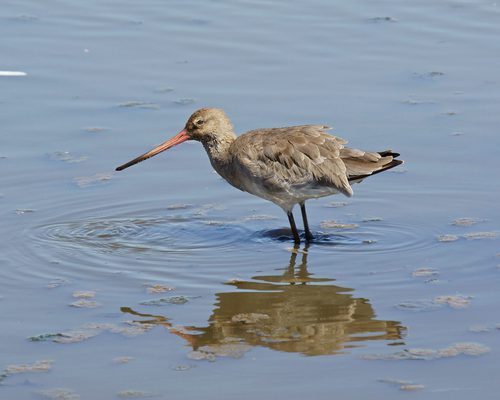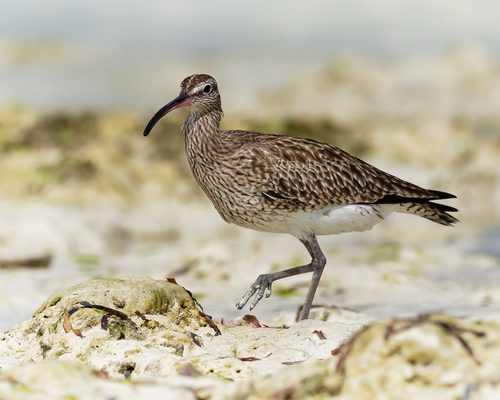Bar-tailed Godwit
Limosa lapponica
Visual Identification
Appearance
The Bar-tailed Godwit is a large shorebird with a long, slightly upturned bill. In breeding plumage, males display rich chestnut-red underparts, while females are paler with mottled brown colouration. Both sexes have a distinctive barred tail, giving the species its name.
Non-breeding adults are predominantly grey-brown above and white below, with females appearing larger and paler than males. Juveniles resemble non-breeding adults but have buff-tinged upperparts and a shorter bill.
Size
Length
37cm to 41cm
Wingspan
70cm to 80cm
Weight
190g to 400g
Colours
Males and females have similar plumage
Primary Colour
Brown Grey
Secondary Colour
White
Beak Colour
Pink Black
Leg Colour
Grey
Habitat and Distribution
Habitats
Woodland
Garden
Wetland
Coastal
Urban
Farmland
Grassland
Desert
Tundra
Rainforest
Mountain
Savanna
Distribution
Bar-tailed Godwits inhabit coastal areas, including mudflats, estuaries, and sandy beaches across their vast range. They breed in Arctic tundra regions of Alaska, Scandinavia, and Siberia.
During non-breeding seasons, they migrate to coastal areas in temperate and tropical regions. Significant populations can be found in Australia, New Zealand, Southeast Asia, and parts of Western Europe, including the UK.
Elevation Range
Sea level to 440 meters
Climate zones
Temperate, Subarctic, Tropical
Distribution Map
This map gives you a rough idea of where you might spot a Bar-tailed Godwit. The coloured areas show countries where these birds have been seen.
A few things to keep in mind:
- Birds might not be everywhere in the coloured areas, for example, they may be present around the coast of that country
- Where birds live can change with seasons and available food
- This map is quite simple - it doesn't show exact locations
We're working on making our maps even better! Soon, we hope to show you:
- More detailed maps for bigger countries, including state and region
- How birds move around during different seasons
Distribution by Region
Behaviour and Ecology
Bird Attributes
This feature is in beta. We'd love your feedback to improve it!
Share your thoughtsBird Attributes Explained
Our bird attributes system rates various aspects of a bird's capabilities on a scale of 0-100, based on data from field observations, scientific studies, and expert knowledge.
Attribute Categories:
- Agility: Manoeuvrability, speed, and grace in flight or movement.
- Strength: Physical power, often correlating with size and hunting abilities.
- Adaptability: Ability to thrive in various environments or changing conditions.
- Aggressiveness: Territorial behaviour and assertiveness, particularly during breeding seasons.
- Endurance: Stamina, often seen in migration patterns or foraging behaviours.
Understanding the Ratings:
- 0-20: Very Low
- 21-40: Low
- 41-60: Average
- 61-80: High
- 81-100: Very High
Remember, these attributes are relative to other bird species and don't necessarily indicate superiority.
Hover over the icon next to each attribute for more information.
Tap the icon next to each attribute for more information.
Agility
Reflects the bird's manoeuvrability, speed, and grace in flight or movement.
The Bar-tailed Godwit demonstrates remarkable agility in flight, capable of precise manoeuvres during its long-distance migrations and aerial displays. Its ability to navigate diverse coastal environments and probe for food with accuracy also indicates high agility.
Strength
Indicates the bird's physical power, often correlating with size and hunting abilities.
Whilst not exceptionally strong for its size, the Bar-tailed Godwit possesses sufficient strength to undertake gruelling long-distance flights and to probe deeply into mud and sand for food. Its ability to double its body weight before migration suggests a robust physique.
Adaptability
Represents the bird's ability to thrive in various environments or changing conditions.
The Bar-tailed Godwit shows extraordinary adaptability, thriving in various coastal habitats across multiple climate zones. Its capacity to adjust to seasonal changes, including altering bill length and dramatically increasing body mass for migration, demonstrates remarkable adaptability.
Aggressiveness
Measures the bird's territorial behaviour and assertiveness, particularly during breeding seasons.
Generally non-aggressive, Bar-tailed Godwits are often seen foraging in large flocks. However, they may display some aggression during breeding season, particularly in defending nesting territories. Their focus seems more on endurance than confrontation.
Endurance
Reflects the bird's stamina, often seen in migration patterns or foraging behaviours.
The Bar-tailed Godwit's endurance is truly exceptional. Its ability to fly non-stop for up to nine days, covering distances of up to 11,000 km, places it at the pinnacle of avian endurance. This unparalleled feat of stamina and persistence earns it the highest possible endurance rating.
Diet
Bar-tailed Godwits primarily feed on invertebrates such as worms, molluscs, and crustaceans. They use their long, sensitive bills to probe deep into mud or sand, often feeding in rhythm with the tides.
During the breeding season, they may also consume berries and insects.
Behaviour
Bar-tailed Godwits are known for their incredible long-distance migrations, flying non-stop for up to nine days. They forage by probing their long bills deep into mud or sand, often in large flocks.
During the breeding season, males perform elaborate aerial displays to attract mates.
Vocalisation
Bar-tailed Godwits have a variety of calls, including a soft, piping 'ku-wee' or 'ku-wee-wee' often heard in flight.
During the breeding season, males produce a series of rapid, descending notes as part of their display, sounding like 'tu-tu-tu-tu-tu'.
Nesting & Breeding
Bar-tailed Godwits form monogamous pairs each breeding season, typically arriving on Arctic breeding grounds in late May or early June. Males perform elaborate aerial displays to attract females.
Nests are simple scrapes on the ground, often lined with lichen or leaves. Females usually lay four olive-green eggs with dark spots. Both parents share incubation duties.
The incubation period lasts about 20-21 days. Chicks are precocial, leaving the nest shortly after hatching. They fledge after 28-30 days, quickly preparing for their first long-distance migration.
Conservation and Status
Global Conservation Status
While currently listed as Near Threatened Globally, Bar-tailed Godwits face threats from habitat loss due to coastal development and climate change.
Conservation efforts focus on protecting key stopover sites along their migration routes and preserving breeding grounds in the Arctic. In Europe, Bar-tailed Godwits are listed as Least Concern.
Birdwatching Tips
- Look for Bar-tailed Godwits on coastal mudflats and estuaries during migration seasons.
- Observe their distinctive feeding behaviour, probing deeply into the mud with their long bills.
- Listen for their soft, piping calls, especially when in flight.
- In the UK and New Zealand, watch for large flocks during spring and autumn migrations.
Additional Information
Quick Facts
Other names:
Kuaka, Pacific Bar-tailed Godwit
Family:
ScolopacidaeAverage Lifespan
5 to 15 years
Max Lifespan
34 years [4]
Predators
Did You Know?
- Bar-tailed Godwits hold the record for the longest non-stop flight of any land bird, flying up to 11,000 km in one go.
- They can double their body weight before migration, storing fat for their long journey.
- Their long bills can change length seasonally, growing longer in winter for probing deeper into mud.
FAQs
How far can a Bar-tailed Godwit fly?
Bar-tailed Godwits can fly an astonishing 11,000 kilometres (7,000 miles) non-stop between the tundra of Western Alaska and the shores of New Zealand, the longest single flight known. Those birds take a longer return route via China to complete a staggering annual migration of approximately 29,000 kilometres or 18,000 miles.
How fast do Bar-tailed Godwits fly?
Bar-tailed Godwits are fast-flying birds that can travel at 70 to 80 kilometres (43 - 50 miles) per hour, although favourable winds allow them to travel much faster, and headwinds make the going much slower. Even at these speeds, their longest migrations may require more than eight days of non-stop flight!
Do Bar-tailed Godwits sleep while flying?
It is unknown whether Bar-tailed Godwits sleep during migration because they are so difficult to monitor. However, other long-flying species like Frigatebirds have the ability to put one-half of their brains to sleep during flight (a process known as unihemispheric sleep) and the Godwits may be able to do the same.
Similar Birds
References
- 1 3
website: BirdLife International. 2017. Limosa lapponica (amended version of 2016 assessment). The IUCN Red List of Threatened Species 2017: e.T22693158A111221714.
View source - 2
report, 2017: Wetlands International
- 4
website, 2012: Robinson and Clark, The Online Ringing Report: Bird ringing in Britain & Ireland in 2011
View source
Share Your Feedback
We value your opinion! Let us know what you think about this bird page.

